Marketplace shift in Germany: The role of Chinese brands
Written by
Editorial TeamPublished on
According to ECDB data, Chinese eCommerce platforms such as AliExpress, Temu, and SHEIN are gradually gaining ground in Germany’s marketplace landscape, showing significant growth rates. However, Germany remains a secondary market for these platforms due to the strong presence of local players like Otto and Zalando, which continue to dominate with established customer loyalty and brand recognition. (Ad)
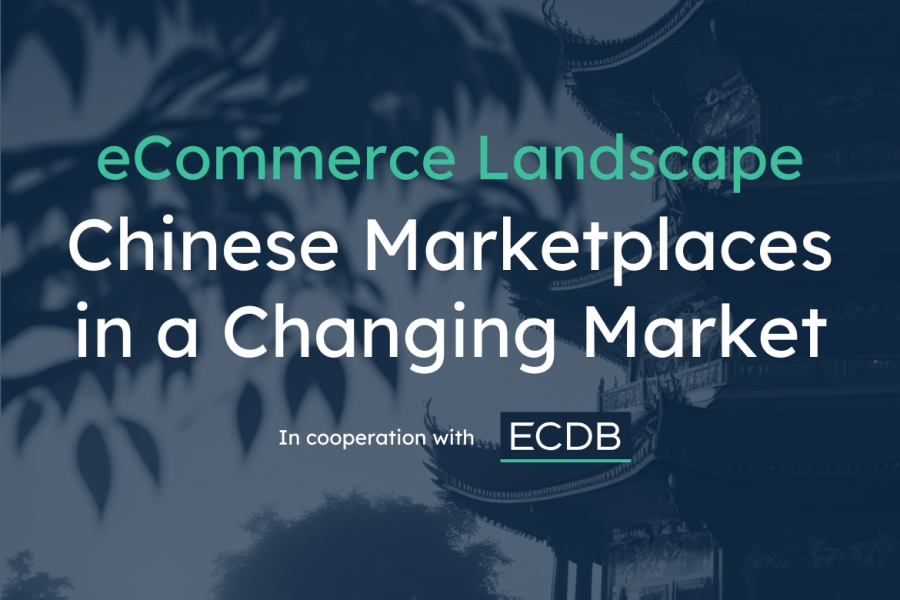
Commercial collaboration
By Nadine Koutsou-Wehling, Data Journalist at ECDB
Amazon, eBay, Otto, Zalando, Kaufland – retailers are stepping up their marketplace game in Germany, and consumers are becoming accustomed to ordering products from eCommerce marketplaces.
For consumers, the differences between a marketplace and online store are not always clear, but for retailers there is a huge difference. Setting up a marketplace platform can significantly enhance a retailer’s visibility, but there are also risks involved, usually through higher costs.
In addition to figuring out which concept to use, there are outside influences to consider. Chinese marketplaces in particular are making German retailers nervous. AliExpress, Temu, SHEIN: Is it probable they will shape the market in any significant way?
Using proprietary ECDB data, the following illustrates the marketplace landscape in Germany, its origin, reach, and outlook.
Online marketplaces experienced their most significant rise in recent years
Germany has traditionally been an eCommerce market with a stronger focus on online stores. But this has changed in recent years. Just five years ago, marketplaces generated significantly lower sales than online stores. While this also left more room for growth, external circumstances suddenly reversed the dynamic.
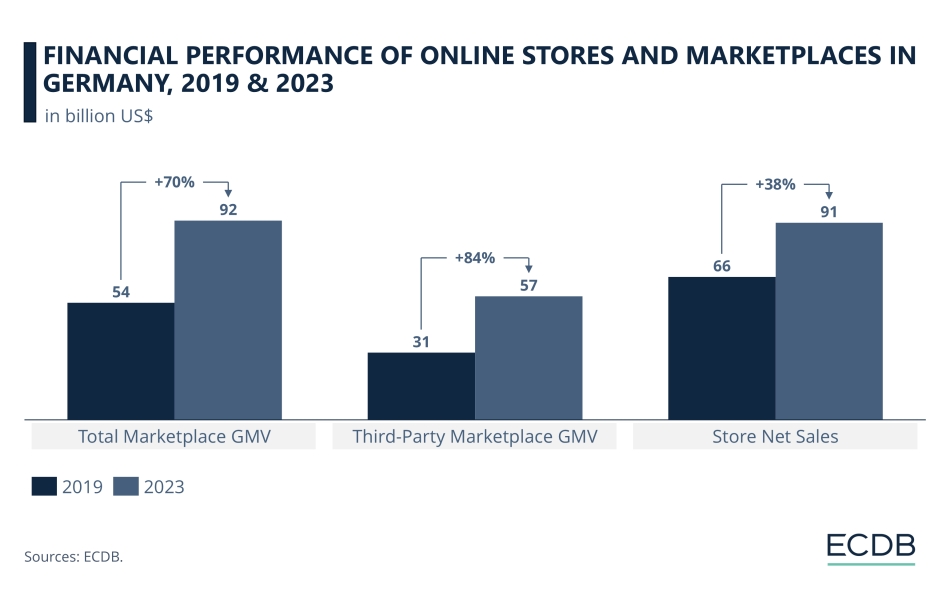
In 2019, online stores were ahead of marketplaces by US$7 billion. But the lead did not last long. Over the course of the pandemic, online marketplaces caught up to online store net sales.
By 2023, total marketplace GMV already outpaced store net sales in Germany, having grown by 70% over the past four years. Marketplace growth was driven primarily by 3P marketplace GMV, which grew 84% over that period.
Not just Chinese marketplaces: The benefits of the marketplace model for retailers in Germany
For consumers, it means a larger selection of products gathered in one place. For vendors, it means a broader customer base without the need for large infrastructure investments. And for the operators of these platforms, it is healthy margins without the many risks of consumer-facing retail.
After just five years, almost 30% of Otto’s gross merchandise value (GMV) is generated by 3P activities. Zalando shows a similar rate of 24%, while external sellers make up more than 80% of Kaufland’s marketplace sales. Other players with strong roots in brick-and-mortar retail, such as Hornbach or Bauhaus, are only just entering the marketplace business.
Amazon and eBay: Two US marketplaces on top
And while the advantages of marketplace development are undeniable, it is also a response to outside pressures. Many of the large American platforms operating in Germany, say Amazon, eBay or Etsy, have a head start on many of their German competitors.
Among them, Amazon takes the lead over all international and domestic platforms. No other online marketplace in the country approaches the US$56 billion Amazon Marketplace generated in 2023.
Since neither the German economy, nor eCommerce is isolated, international developments have a clear effect on the market. Germany’s top 10 marketplaces are of mixed origin, but domestic retailers remain important. This is most evident in the success of Otto, Zalando, Media Markt, Kaufland, ABOUT YOU and Saturn.
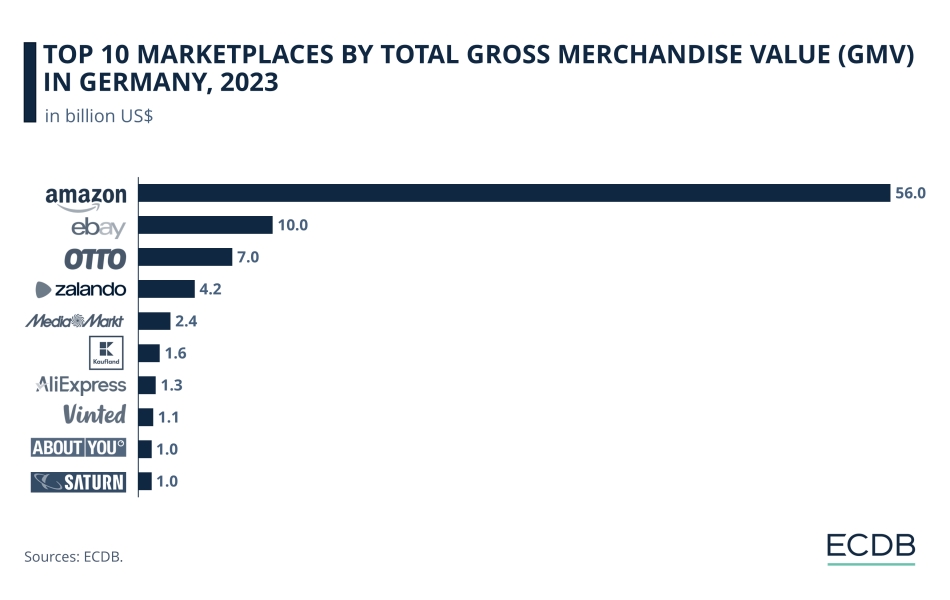
Apart from the origin of marketplace providers, there are also cross-border sales to consider. What role do imports and exports play in German eCommerce?
Cross-border eCommerce in Germany: Online stores are stronger in exports, marketplaces dominate imports
It was previously stated that online stores have traditionally been the stronger eCommerce revenue driver in Germany, while marketplaces only became more important in recent years. This is not the case globally: Marketplaces have been outperforming online stores for years.
The impact of German online stores therefore extends far beyond domestic borders: Cross-border exports of online stores in Germany are much higher than export GMV of marketplaces. But the latter have seen substantial growth recently:
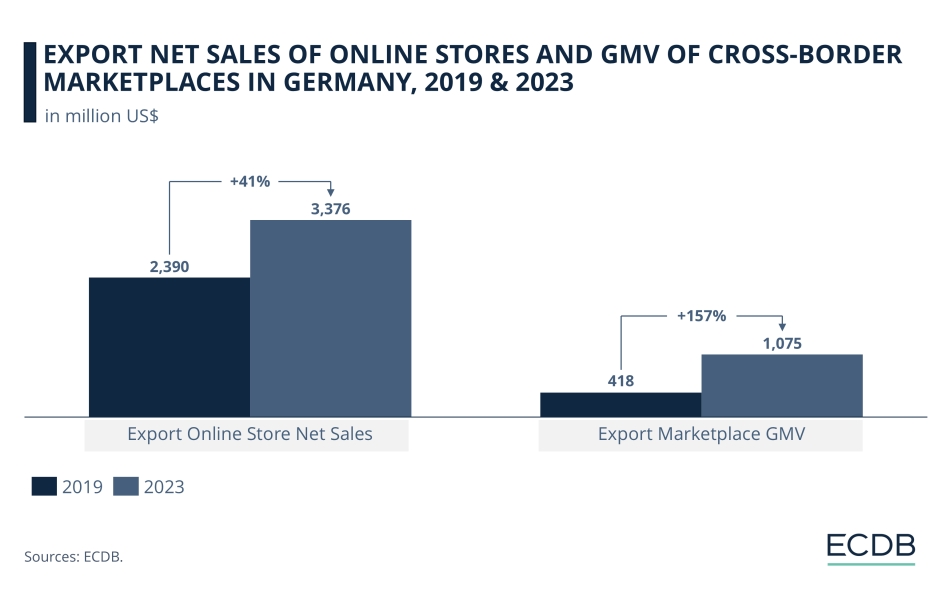
German online stores are stronger in exports due to favorable brand reputation abroad, especially in neighboring countries. Considering that Germany’s top 3 eCommerce export partners are Austria (48.6%), Switzerland (19.8%) and the Netherlands (4.2%), similar language and cultural preferences would mean that consumers in these countries are particularly susceptible to the influence of German brands.
International marketplaces import higher values
When it comes to imports, marketplaces take the lead – meaning that international marketplaces generated higher sales in Germany compared to foreign online stores. This was not the case in 2019, when foreign online stores were slightly larger than marketplaces.

But marketplace GMV outpaced online store net sales in imports, both coming from a similar level in 2019. Marketplace GMV in imports grew 170% from 2019 to 2023, compared to 93% growth in online store net sales in imports.
The reasons why international marketplaces contribute more imports than online stores are as follows: First, international marketplaces provide a wide variety of products to choose from and lower-priced offers, a primary reason consumers will want to venture outside of their home market to explore less expensive products. Integration with platforms via tools like the AliExpress API also enables retailers to automate listings and streamline order processing, making cross-border commerce more accessible.
Second, the logistics capabilities of international eCommerce have evolved tremendously in recent years and continue to improve. This makes it faster, more convenient and more accessible for German consumers to order global products.
The top 3 import partners are Switzerland (32.9%), the United States (25%) and Turkey (20.2%). China is nowhere to be seen in the top 3 in either direction. Yet no one seems to stop talking about the impact of Chinese marketplaces.
Chinese marketplaces are not yet taking a significant lead in Germany, but could they do so in the future?
The key to understanding the development of Chinese international eCommerce and its impact in Europe is that Chinese retailers are subject to the same pressures as the retailers in Germany, France or the United States. Almost all of the Chinese giants of eCommerce are publicly listed companies that have to meet expectations for revenue growth and profitability.
Within the European continent, however, Germany is of secondary importance to Chinese eCommerce platforms, compared to other markets.
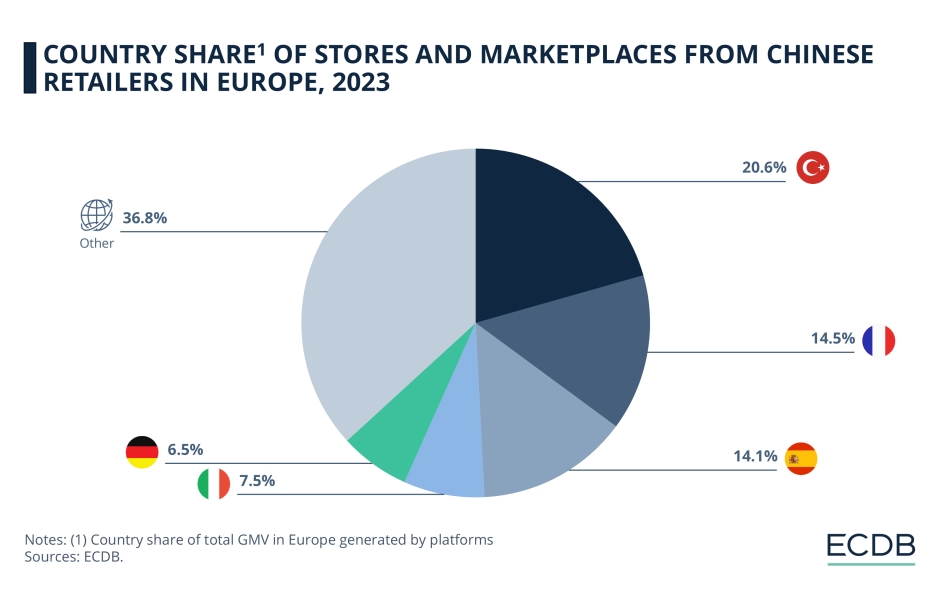
Germany accounts for only 6.5% of all European business for Chinese companies, despite its status as the second largest eCommerce market in Europe. This is not to say that marketplaces such as AliExpress and Temu are not successful in the German market. There are simply other markets that are more receptive to low-cost offerings and have fewer domestic eCommerce competitors.
Due to the size of the market, Germany has a stronger group of established domestic companies such as Otto, Zalando or Ceconomy, which make it difficult to break into the market. Even SHEIN with its trend-led fast fashion strategy is only the eighteenth largest online store in Germany.
Although Germany is a secondary market for Chinese international eCommerce, its influence is still growing
Chinese platforms have more important international markets than Germany. This does not mean, however, that their presence in German eCommerce is negligible. The four platforms with a relevant presence in Germany are AliExpress and Trendyol (both by Alibaba), Temu (PDD Holdings) and SHEIN (Roadget Business).
All of these retailers have shown at least double-digit growth over the past year. Temu is the obvious standout among a group of successful players. After its launch in 2022, the marketplace has grown rapidly to almost US$750 million in just one year, which makes it the 13th-largest marketplace in Germany.

Chinese platforms have grown in double-digit dimensions already before Temu drove up the rates in its launch year of 2022. This is a level of growth that German retailers can only dream of. The average German marketplace grew by just 5.6% in 2023. Online stores even declined by an average of 1.2%.
The comparison confirms why Chinese online marketplaces are so much in the news right now. Not only are the growth rates driven by Temu unparalleled in the market, they also point to a future potential that challenges the business models of domestic players.
A look ahead: The marketplace business model prevails, but the role of Chinese players remains uncertain
Online stores are a fundamental contributor to eCommerce revenues in Germany. At the same time, market analysis based on our ECDB proprietary data suggests that the trend of marketplace expansion will continue in the coming years – a development driven by the benefits of the marketplace business model. The international component is equally expected to grow.
It is true that low prices lure consumers everywhere, including Germany. But at the same time, consumer preferences in the market lean toward domestic players or large international players with global renown. The influence of platforms like AliExpress, Temu, and Trendyol is certainly notable, offering consumers attractive, budget-friendly options. However, as shoppers become more discerning, there is a possibility that the appeal of these platforms may evolve, particularly if affordability sometimes comes at the expense of consistent quality.
***


